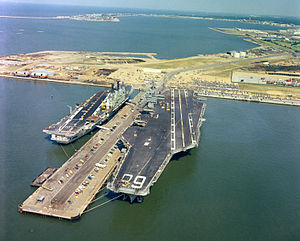Estia-class carrier
 Estia undergoing crew transfer during Operation Kipling
| |
| Class overview | |
|---|---|
| Name: | Estia-class aircraft carrier |
| Builders: | O’Shea Container Shipping |
| Operators: | Burgoignesc Security Forces |
| Preceded by: | Faramount Class |
| Succeeded by: | Bourgondi Class |
| Built: |
|
| In service: |
|
| Planned: | 11 |
| Completed: | 11 |
| Laid up: | 2 |
| Lost: | 0 |
| Retired: | 8 |
| Preserved: | 1 |
| General characteristics | |
| Class and type: | Estia-class aircraft carrier |
| Displacement: |
|
| Length: |
|
| Beam: |
|
| Draft: |
|
| Propulsion: | |
| Speed: | 32.1 kn (36.9 mph; 59.4 km/h) |
| Range: | 5,200 nautical miles (9,300 km) at 25 knots |
| Complement: | 2,230 (2,620 inc. air staff) |
| Sensors and processing systems: | tbd |
| Electronic warfare & decoys: | tbd |
| Armament: |
|
| Armor: | 3.5" waterline belt, 2" deck armor |
| Aircraft carried: |
|
| Aviation facilities: | CATOBAR style flight deck |
| Notes: | Equipped with 2 steam-powered catapults. |
The Estia class is a class of aircraft carriers developed by Burgundie in the 1950s following the production of the Faramount class. Initially designed as a small fleet carrier, the class was constructed in two flights in the 1950s and 1960s, and constituted the primary naval aviation force of the Burgoignesc Security Forces for the majority of the Cold War. The award of the entire class's production to O’Shea Container Shipping was broadly considered the final blow to competition between O'Shea and rival corporation Lansing Lines for monopoly over the major shipbuilding industry in Burgundie.
Design and Construction
O'Brien Affair
In 1965, it was publicly revealed in the Levantine Times Union that the second hull of the second flight of the Estia class had been purchased by the Fhainnin Navy. Though at the time only beginning keel-laying, the revelation was a political scandal which saw dual citizen George O'Brien, who owned 3% of shares in O'Shea, lose his Burgoignesc citizenship and be forced to sell his holdings in the country. While Faneria and Fiannria would normalize relations before the hull was to have been completed, making the sale of the vessel technically legal through the voiding of the remaining stipulations of the Treaty of Loughlin, the government of Burgundie faced strong pressure from Urcea and to a lesser extent Fiannria to void the sale of the ship.
In response, O'Shea would change construction partway through, renegotiating to sell the hull to Puertego as the smaller unique carrier PGT Torres. Faneria subsequently contracted the four treaty-legal Barefield class.
Ships in Class
Operational History

During Operation Kipling, which took place from 1962 to 1976, the Estia class aircraft carriers played a crucial role in the Navy of Burgundie's military strategy in Audonia. The Navy's approach to the conflict was characterized by a combination of air and naval power, primarily facilitated by the use of their aircraft carriers, chief among them was the Estia class.
In the early stages of the war, the Estia class carriers served as instrumental platforms for projecting air power over the contested areas, including Kandara, Oyashima, and Pursat all beyond the reach of land based aircraft stationed on Alcairet, Chaukhira, and Salarive. The carriers were seen as key assets for the Burgoignesc military to assert dominance in the region, allowing them to conduct airstrikes, provide air support to ground troops, and conduct reconnaissance missions.
Burgoignesc aircraft carrier doctrine emphasized the strategic importance of maintaining air superiority and providing close air support for ground forces. The carriers were used to deploy a mix of fighter aircraft, bombers, and reconnaissance planes to conduct offensive operations against communist and socialist forces, disrupting supply lines and targeting key enemy positions. These operations were crucial in sustaining the Burgoignesc military presence and control over certain areas during the conflict.
The Estia aircraft carriers also served as a means of logistical support, enabling the transportation of troops, equipment, and supplies to various locations within the region. This logistical function was essential for maintaining the Burgoignesc military's operational capacity and reinforcing their positions in the face of persistent communist/socialist resistance.
However, despite the strategic advantages offered by the aircraft carriers, the Navy of Burgundie faced several challenges during the war, including the limited availability of carriers, logistical constraints, the disparate battlefields, and the evolving tactics of the communist/socialist forces. The increasing use of inland guerrilla warfare and the vast expanses in the region made it challenging for the Burgundie to fully leverage the capabilities of their carriers and achieve decisive victories.
The entire class went under refits from 1975 to 1985, including more extensive work on the Flight 1 carriers. This process generally homogenized the class's displacement and equipment characteristics.
See Also
Ships of comparable role and era: